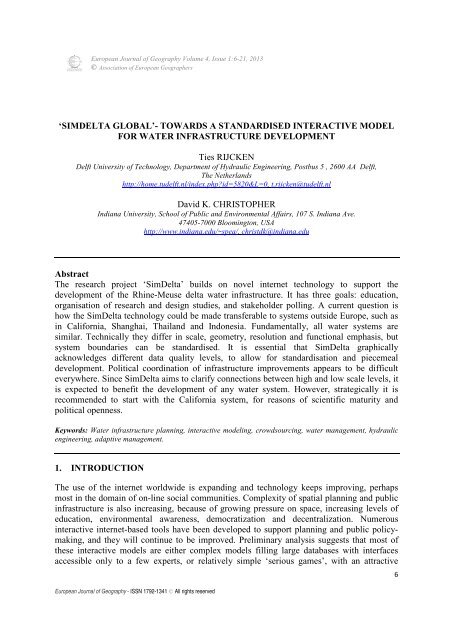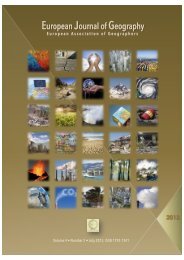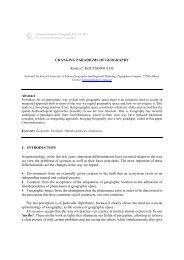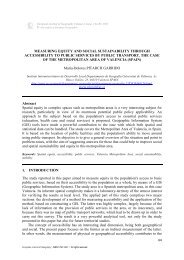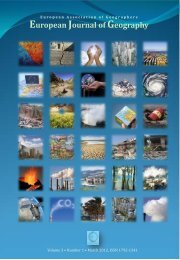European Journal of Geography
European Journal of Geography
European Journal of Geography
Create successful ePaper yourself
Turn your PDF publications into a flip-book with our unique Google optimized e-Paper software.
<strong>European</strong> <strong>Journal</strong> <strong>of</strong> <strong>Geography</strong> Volume 4, Issue 1:6-21, 2013<br />
© Association <strong>of</strong> <strong>European</strong> Geographers<br />
‘SIMDELTA GLOBAL’- TOWARDS A STANDARDISED INTERACTIVE MODEL<br />
FOR WATER INFRASTRUCTURE DEVELOPMENT<br />
Ties RIJCKEN<br />
Delft University <strong>of</strong> Technology, Department <strong>of</strong> Hydraulic Engineering, Postbus 5 , 2600 AA Delft,<br />
The Netherlands<br />
http://home.tudelft.nl/index.php?id=5820&L=0, t.rijcken@tudelft.nl<br />
David K. CHRISTOPHER<br />
Indiana University, School <strong>of</strong> Public and Environmental Affairs, 107 S. Indiana Ave.<br />
47405-7000 Bloomington, USA<br />
http://www.indiana.edu/~spea/, christdk@indiana.edu<br />
Abstract<br />
The research project ‘SimDelta’ builds on novel internet technology to support the<br />
development <strong>of</strong> the Rhine-Meuse delta water infrastructure. It has three goals: education,<br />
organisation <strong>of</strong> research and design studies, and stakeholder polling. A current question is<br />
how the SimDelta technology could be made transferable to systems outside Europe, such as<br />
in California, Shanghai, Thailand and Indonesia. Fundamentally, all water systems are<br />
similar. Technically they differ in scale, geometry, resolution and functional emphasis, but<br />
system boundaries can be standardised. It is essential that SimDelta graphically<br />
acknowledges different data quality levels, to allow for standardisation and piecemeal<br />
development. Political coordination <strong>of</strong> infrastructure improvements appears to be difficult<br />
everywhere. Since SimDelta aims to clarify connections between high and low scale levels, it<br />
is expected to benefit the development <strong>of</strong> any water system. However, strategically it is<br />
recommended to start with the California system, for reasons <strong>of</strong> scientific maturity and<br />
political openness.<br />
Keywords: Water infrastructure planning, interactive modeling, crowdsourcing, water management, hydraulic<br />
engineering, adaptive management.<br />
1. INTRODUCTION<br />
The use <strong>of</strong> the internet worldwide is expanding and technology keeps improving, perhaps<br />
most in the domain <strong>of</strong> on-line social communities. Complexity <strong>of</strong> spatial planning and public<br />
infrastructure is also increasing, because <strong>of</strong> growing pressure on space, increasing levels <strong>of</strong><br />
education, environmental awareness, democratization and decentralization. Numerous<br />
interactive internet-based tools have been developed to support planning and public policymaking,<br />
and they will continue to be improved. Preliminary analysis suggests that most <strong>of</strong><br />
these interactive models are either complex models filling large databases with interfaces<br />
accessible only to a few experts, or relatively simple ‘serious games’, with an attractive<br />
<strong>European</strong> <strong>Journal</strong> <strong>of</strong> <strong>Geography</strong> - ISSN 1792-1341 © All rights reserved<br />
6


